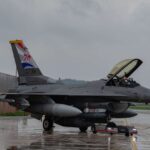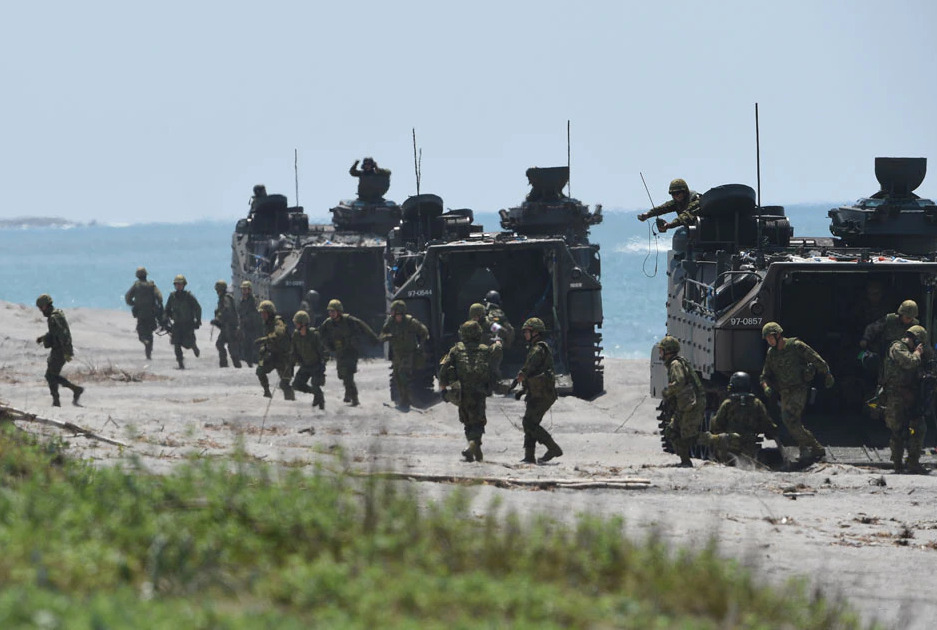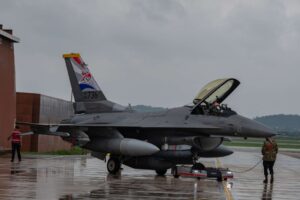The US and Japan announced a significant strengthening of their military relationship and upgrade of the US military’s force posture in the country on Wednesday, including the stationing of a newly redesignated Marine unit with advanced intelligence, surveillance capabilities and the ability to fire anti-ship missiles, according to two US officials briefed on the matter.
US Defense Secretary Lloyd Austin said during a press conference with Secretary of State Antony Blinken, Japanese Foreign Minister Hayashi Yoshimasa, and Japanese Defense Minister Hamada Yasukazu, that the 12th Marine Regiment, an artillery regiment, would be redesignated as the 12th Marine Littoral Regiment.
“We’re replacing an artillery regiment with an outfit that’s, that’s more lethal, more agile, more capable,” he said, adding that the move would “bolster deterrence in the region and allow us to defend Japan and its people more effectively.”
The announcement sends a strong signal to China and came as part of a series of initiatives designed to underscore a rapid acceleration of security and intelligence ties between the countries.
The officials met on Wednesday as part of the annual US-Japan Security Consultative Committee meeting, days before President Joe Biden plans to meet with Japanese Prime Minister Fumio Kishida at the White House.
The newly revamped Marine unit will be based on Okinawa and is intended to provide a stand-in force that is able to defend Japan and quickly respond to contingencies, US officials said Wednesday. Okinawa is viewed as key to the US military’s operations in the Pacific – in part because of its close proximity to Taiwan. It houses more than 25,000 US military personnel and more than two dozen military installations. Roughly 70% of the US military bases in Japan are on Okinawa; one island within the Okinawa Prefecture, Yonaguni, sits less than 70 miles from Taiwan, according to the Council on Foreign Relations.
It is one of the most significant adjustments to US military force posture in the region in years, one official said, underscoring the Pentagon’s desire to shift from the wars of the past in the Middle East to the region of the future in the Indo-Pacific. The change comes as simulated war games from a prominent Washington think tank found that Japan, and Okinawa in particular, would play a critical role in a military conflict with China, providing the United States with forward deployment and basing options.
“I think it is fair to say that, in my view, 2023 is likely to stand as the most transformative year in US force posture in the region in a generation,” said Ely Ratner, the Assistant Secretary of Defense for Indo-Pacific Security Affairs, at the American Enterprise Institute last month.
The news follows the stand-up of the first Marine Littoral Regiment in Hawaii last year, in which the 3rd Marine Regiment in Hawaii became the 3rd Marine Littoral Regiment – a key part of the Marine Corps’ modernization effort outlined in the 2030 Force Design report from Gen. David Berger.
As the service has described them, the Marine Littoral Regiments are a “mobile, low-signature” unit able to conduct strikes, coordinate air and missile defense and support surface warfare.
Attacks from space
In addition to the restructuring of Marines in the country, the US and Japan announced on Wednesday that they are expanding their defense treaty to include attacks to or from space amid growing concern about the rapid advancement of China’s space program and hypersonic weapons development.
In November, China launched three astronauts to its nearly completed space station as Beijing looked to establish a long-term presence in space. China has also explored the far side of the moon and Mars.
The two allies announced that Article V of the US-Japan Security Treaty, first signed in 1951, applies to attacks from or within space, officials said. In 2019, the US and Japan made it clear that the defense treaty applies to cyberspace and that a cyber attack could constitute an armed attack under certain circumstances.
“We’re working to deepen our cooperation across every realm: Land, sea, air, and yes, space – cyber and outer,” Blinken said Wednesday. “The outer space component of this is important security and prosperity of our alliance. We agree, as you’ve heard, that attacks to, from, or within space present a clear challenge, and we affirm that depending on the nature of those attacks this could lead to the invocation of Article V of our Japan-US security treaty.”
Blinken added that he and Yoshimasa would sign a space agreement later this week during a visit to NASA headquarters in Washington. A release on Wednesday from NASA said the agreement will “build on the nations’ commitment to the peaceful, transparent exploration of space.”
The US has watched closely as China has rapidly developed its hypersonic weapon systems, including one missile in 2021 that circled the globe before launching a hypersonic glider that struck its target. It was a wake-up call for the United States, which has fallen behind China and Russia in advanced hypersonic technology.
The two countries will also build on their joint use of facilities in Japan and carry out more exercises on Japan’s southwest islands, a move sure to draw the ire of Beijing, given its proximity to Taiwan and even mainland China. US officials added that the US will temporarily deploy MQ-9 Reaper drones to Japan for maritime surveillance of the East China Sea, as well as launch a bilateral group to analyze and share the information.
Japan’s biggest military buildup since World War II
The announcements came less than a month after Japan unveiled a new national security plan that signals the country’s biggest military buildup since World War II, doubling defense spending and veering from its pacifist constitution in the face of growing threats from regional rivals, including China.
China has been growing its naval and air forces in areas near Japan while claiming the Senkaku Islands, an uninhabited Japanese-controlled chain in the East China Sea, as its sovereign territory.
In late December, Japan said Chinese government vessels had been spotted in the contiguous zone around the Senkakus, known as the Diaoyus in China, 334 days in 2022, the most since 2012 when Tokyo acquired some of the islands from a private Japanese landowner, public broadcaster NHK reported. From December 22 to 25, Chinese government vessels spent almost 73 consecutive hours in Japanese territorial waters off the islands, the longest such incursion since 2012, the NHK report said.
China has also been upping its military pressure on Taiwan, the self-governing island, whose security Japanese leaders have said is vital to the security of Japan itself. In August, that pressure included Beijing firing five missiles that landed in Japan’s exclusive economic zone near Taiwan in response to the visit of then-US House Speaker Nancy Pelosi to Taipei.
Before the announcement of the increased partnership between the US and Japan was even made public, Chinese government officials were reacting to reports in Japanese media.
“US-Japan military cooperation should not harm the interests of any third party or undermine peace and stability in the region,” Chinese Foreign Ministry spokesperson Wang Wenbin said at a regular press briefing Tuesday in Beijing.
A State Department official explained that the Ukraine war and strengthening of the China-Russia relationship have spurred the US and Japan to come to a series of new agreements that have been under consideration for some time.
“Russia’s invasion of Ukraine, sort of moved things on warp drive a little bit,” the official said. “The relationship between Putin and Xi Jinping that we saw in the lead up to the Beijing Olympics, that kind of showed, wait a minute, the Russians and the Chinese are working in new ways. We’re facing new challenges.”
And it’s not just the US – Japan and Britain also announced on Wednesday that the two countries would be signing a “historic defense agreement” that would allow them to deploy forces in each other’s countries.
The Reciprocal Access Agreement will allow both forces to plan military exercises and deployments on a larger and more complex scale, making it the “most significant defense agreement between the two countries in more than a century,” according to a statement on Wednesday from Downing Street.
The agreement still needs to be ratified by the respective parliaments before taking effect. It will be laid before Japan’s Diet and the UK Parliament in the coming weeks, according to the statement.
Source : CNN
















